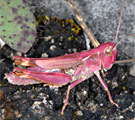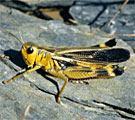Isophya kraussii (Brunner von Wattenwyl, 1878)
![Isophya kraussii: Male (S-Germany, NW-Bavaria, Kreis Würzburg, early July 2023) [N] Isophya kraussii: Male (S-Germany, NW-Bavaria, Kreis Würzburg, early July 2023) [N]](thumbs/tettigoniidae/kraussi_im2023.jpg)
![Isophya kraussii: Male (S-Germany, NW-Bavaria, Kreis Würzburg, early July 2023) [N] Isophya kraussii: Male (S-Germany, NW-Bavaria, Kreis Würzburg, early July 2023) [N]](thumbs/tettigoniidae/kraussi_2im2023.jpg)
![Isophya kraussii: Male (S-Germany, NW-Bavaria, Kreis Würzburg, early July 2023) [M] Isophya kraussii: Male (S-Germany, NW-Bavaria, Kreis Würzburg, early July 2023) [M]](thumbs/tettigoniidae/kraussi_3im2023.jpg)
![Isophya kraussii: Male (S-Germany, NW-Bavaria, Kreis Würzburg, early July 2023) [M] Isophya kraussii: Male (S-Germany, NW-Bavaria, Kreis Würzburg, early July 2023) [M]](thumbs/tettigoniidae/kraussi_4im2023.jpg)
![Isophya kraussii: Female (S-Germany, eastern Swabian Alb, Heidenheim-Fleinheim, late June 2023) [N] Isophya kraussii: Female (S-Germany, eastern Swabian Alb, Heidenheim-Fleinheim, late June 2023) [N]](thumbs/tettigoniidae/kraussi_5im2023.jpg)
![Isophya kraussii: Female (S-Germany, eastern Swabian Alb, Heidenheim-Fleinheim, 11. July 2022) [N] Isophya kraussii: Female (S-Germany, eastern Swabian Alb, Heidenheim-Fleinheim, 11. July 2022) [N]](thumbs/tettigoniidae/kraussi_im2022.jpg)
![Isophya kraussii: Female (S-Germany, eastern Swabian Alb, Heidenheim-Fleinheim, 11. July 2022) [N] Isophya kraussii: Female (S-Germany, eastern Swabian Alb, Heidenheim-Fleinheim, 11. July 2022) [N]](thumbs/tettigoniidae/kraussi_2im2022.jpg)
![Isophya kraussii: Female in a humid, late mown and large-forb-rich meadow (S-Germany, Baden-Württemberg, Mainhardt, 05. July 2010) [N] Isophya kraussii: Female in a humid, late mown and large-forb-rich meadow (S-Germany, Baden-Württemberg, Mainhardt, 05. July 2010) [N]](thumbs/tettigoniidae/kraussi_wim2010.jpg)
![Isophya kraussii: Male (eastern Swabian Alb, southern Germany) [N] Isophya kraussii: Male (eastern Swabian Alb, southern Germany) [N]](thumbs/tettigoniidae/kraussi_2m2009.jpg)
![Isophya kraussii: Male (eastern Swabian Alb, S-Germany) [N] Isophya kraussii: Male (eastern Swabian Alb, S-Germany) [N]](thumbs/tettigoniidae/kraussi_3m2009.jpg)
![Isophya kraussii: Male (eastern Swabian Alb 2009) [N] Isophya kraussii: Male (eastern Swabian Alb 2009) [N]](thumbs/tettigoniidae/kraussi_4m2009.jpg)
![Isophya kraussii: Male (eastern Swabian Alb, S-Germany) [N] Isophya kraussii: Male (eastern Swabian Alb, S-Germany) [N]](thumbs/tettigoniidae/kraussi_5m2009.jpg)
![Isophya kraussii: Male (eastern Swabian Alb 2009) [N] Isophya kraussii: Male (eastern Swabian Alb 2009) [N]](thumbs/tettigoniidae/kraussi_6m2009.jpg)
![Isophya kraussii: Male (eastern Swabian Alb, S-Germany) [N] Isophya kraussii: Male (eastern Swabian Alb, S-Germany) [N]](thumbs/tettigoniidae/kraussi_7m2009.jpg)
![Isophya kraussii: Female (eastern Swabian Alb) [N] Isophya kraussii: Female (eastern Swabian Alb) [N]](thumbs/tettigoniidae/kraussi_w08.jpg)
![Isophya kraussii: Female (eastern Swabian Alb) [N] Isophya kraussii: Female (eastern Swabian Alb) [N]](thumbs/tettigoniidae/kraussi_wo82.jpg)
![Isophya kraussii: Female dorsal (eastern Swabian Alb, S-Germany) [N] Isophya kraussii: Female dorsal (eastern Swabian Alb, S-Germany) [N]](thumbs/tettigoniidae/kraussi_wos.jpg)
![Isophya kraussii: Female (eastern Swabian Alb, S-Germany) [N] Isophya kraussii: Female (eastern Swabian Alb, S-Germany) [N]](thumbs/tettigoniidae/kraussi_w2.jpg)
![Isophya kraussii: Male larva in penultimate instar (eastern Swabian Alb, Southern Germany) [N] Isophya kraussii: Male larva in penultimate instar (eastern Swabian Alb, Southern Germany) [N]](thumbs/tettigoniidae/kraussi_ml2009.jpg)
![Isophya kraussii: Half-grown male larva (eastern Swabian Alb, S-Germany) [N] Isophya kraussii: Half-grown male larva (eastern Swabian Alb, S-Germany) [N]](thumbs/tettigoniidae/kraussi_m.jpg)
![Isophya kraussii: Larva (eastern Swabian Alb, S-Germany) [N] Isophya kraussii: Larva (eastern Swabian Alb, S-Germany) [N]](thumbs/tettigoniidae/kraussi_l.jpg)
![Isophya kraussii: Habitat: higher growing limestone grassland on the eastern Swabian Alb [N] Isophya kraussii: Habitat: higher growing limestone grassland on the eastern Swabian Alb [N]](thumbs/tettigoniidae/kraussi_h2009.jpg)
![Isophya kraussii: Habitat (S-Germany, eastern Swabian Alb, Heidenheim-Fleinheim, late June 2023) [N] Isophya kraussii: Habitat (S-Germany, eastern Swabian Alb, Heidenheim-Fleinheim, late June 2023) [N]](thumbs/tettigoniidae/kraussi_6im2023.jpg)
![Isophya kraussii: Habitat (S-Germany, eastern Swabian Alb, Heidenheim-Fleinheim, 11. July 2022) [N] Isophya kraussii: Habitat (S-Germany, eastern Swabian Alb, Heidenheim-Fleinheim, 11. July 2022) [N]](thumbs/tettigoniidae/kraussi_h2022.jpg)
![Isophya kraussii: Habitat in a humid, late mown and high-forb-rich meadow (S-Germany, Baden-Württemberg, Mainhardt, July 2010) [N] Isophya kraussii: Habitat in a humid, late mown and high-forb-rich meadow (S-Germany, Baden-Württemberg, Mainhardt, July 2010) [N]](thumbs/tettigoniidae/kraussi_h2010.jpg)
Nutrition:
herbs, particularly soft plant parts.
Habitat:
Isophya kraussii colonizes dry to mesophilic or rarer even humid herbaceous margins (woodland edges, limestone slopes, embankments, ditches) and also occurs in higher growing nutrient-poor grasslands or on larger clearings.
Life cycle:
The larvae are observed from mid-March, the adults from early June to August/September. The eggs overwinter in the ground several times.
Endangerment: regionally endangered or decreasing
Endangerment factors:
Isophya kraussii is declining due to the uniformization of the landscape. Isophya kraussii has no pretentious requirements and copes with small habitats. So it occurs very isolated near Memmingen (Southern Germany) on one of the last, quite small dry embankments in the Iller Valley. On the Swabian Alb it is also found in herbaceous margins of ordinary woodlands.
Remarks:
Isophya kraussii is best observed as a larva in the April/early May, as the larvae live in the early stages more conspicuously. With the adults bat detectors are recommended, as adults are found more random because of their hidden and camouflaged life.
The distribution is apparently limited to Central Europe (Germany, Czech Republic, Austria and adjacent areas).
Isophya camptoxypha | Isophya hospodar | Isophya miksici | Isophya modesta | Isophya pienensis | Isophya pyrenaea | Isophya rectipennis | Isophya rhodopensis | Isophya speciosa | Isophya tosevski


